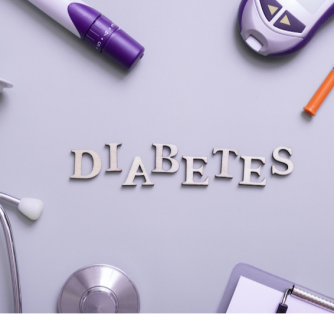Menu
Weight loss
Hormones
Sex
EXPLORE
MEET NU IMAGE MEDICAL
TREATMENTS
MEET NU IMAGE MEDICAL
TREATMENTS
MEET NU IMAGE MEDICAL
Diabetes Insipidus vs Mellitus: What's The Difference?


Over 10 percent of Americans have diabetes. This startling fact comes as no surprise, especially when sugary food and fast food are readily at our disposal. It’s hard to resist. It’s tempting, but at the same time, it puts people at risk of developing diabetes.
However, there are two other unique forms of diabetes: diabetes insipidus and diabetes mellitus. But how are they different? Diabetes insipidus is an uncommon condition in which you urinate a lot and experience extreme thirst. While diabetes insipidus is different from type 1 diabetes and type 2 diabetes, it does share some of the same symptoms and traits.
Diabetes insipidus
The two hallmarks of diabetes insipidus are excessive thirst and excessive urination.
According to PubMed, diabetes insipidus is a complex disease in which urine is diluted in large quantities. If left untreated, diabetes insipidus can cause complications. This condition is life-threatening if it is not managed and monitored properly. However, diabetes insipidus is typically caused by one of two factors. It can be caused by an improper secretion of “antidiuretic hormone (ADH) from the posterior pituitary gland (neurogenic or central diabetes insipidus).”
It can also be caused by “problems with a hormone called vasopressin (AVP).”
Antidiuretic hormone (ADH)
But what is antidiuretic hormone or ADH exactly? According to WebMD, ADH is a hormone that’s responsible for regulating the amount of water in your body. It essentially determines how much water is reabsorbed by your kidneys, while it rids your bloodstream of waste. This hormone is sometimes referred to as arginine vasopressin or AVP. The hypothalamus produces AVP. AVP is housed inside the pituitary gland, where it stays until the body needs it.
Of course, it helps to know what both the hypothalamus and pituitary gland do. According to experts, the hypothalamus is the portion of the brain that regulates hunger and mood, while the pituitary gland controls metabolism, growth, and the reproduction hormones it naturally “produces.”
Causes of diabetes insipidus
Diabetes insipidus may also be caused by an inadequate renal reaction to ADH. This is also known as nephrogenic diabetes insipidus. Diabetes insipidus can result from a number of other factors. These can include severe head trauma that causes damage to the pituitary gland or the hypothalamus. It can also be a result of brain tumor that damages the hypothalamus or pituitary gland.
This condition is surprisingly easy to acquire from events like this. Diabetes insipidus produces a number of symptoms, many of which are different from the symptoms of type 1 diabetes and type 2 diabetes. Those who have diabetes insipidus may experience bed-wetting, according to The Mayo Clinic. Other symptoms of diabetes insipidus include the following:
-
Fever
-
Trouble sleeping
-
Vomiting
-
Constipation
-
Wet and heavy diapers
According to Healthline, there are three prominent features of diabetes. These include polydipsia, which is an increased thirst. It is also characterized by polyuria, which is frequent urination, and polyphagia. Polyphagia is an increase in appetite. Individuals with diabetes insipidus may urinate as many as 20 quarts of urine each day.
But what about diabetes mellitus? What is it exactly, and how does it differ? According to experts, diabetes mellitus is a conglomeration of diseases that affect the body’s ability to process blood sugar or glucose. Glucose provides the cells and muscles with energy, so the body can function properly. Glucose powers the brain and is its primary source of energy. Glucose helps you think clearly. Without it, you can at times develop a brain fog.
According to the Merck Manual, diabetes mellitus is a condition in which your body does not properly respond to insulin and consequently does not manufacture enough of it. This causes blood sugar levels to skyrocket, often leading to unusually high glucose levels.
Because one’s thirst and urination increase with diabetes mellitus, many people lose weight without trying. Blood sugar is unusually high in individuals with diabetes mellitus. Diabetes mellitus is typically diagnosed by observing its symptoms and having blood and urine tests. The results of these tests ultimately determine whether or not one has diabetes mellitus.
More specifically, your doctor may recommend that you get a fasting glucose test. For this test, a doctor will draw blood after you have not eaten for a minimum of eight hours. You can also have an A1c test. Also called a glycated hemoglobin test, an A1c test measures your blood sugar levels over a period of three months. This test is commonly used to determine if one has prediabetes. This test also helps you and your healthcare team develop a diet and treatment plan that best fits your situation.
However, it is important to know what you must do if you are diagnosed with diabetes mellitus. According to experts, treatment for diabetes mellitus is typically through injections and a modification in diet. If one is overweight, exercise may be required for treatment.
The symptoms, treatment, and diagnosis of diabetes mellitus are the same in children as they are in adults. However, the question remains: What is the difference between diabetes insipidus and diabetes mellitus? With diabetes mellitus, one’s glucose or blood sugar levels are unusually high. As a result, the kidneys have to work extra hard to eliminate extra glucose in your system. This glucose is eliminated through urine, and many people find that they require extra fluids all the time.
Although diabetes insipidus and diabetes mellitus are alike in several ways, they are not the same condition. Both conditions create an uptick in urination and thirst. With diabetes mellitus, your blood sugar levels are too high, and your kidneys struggle to compensate by passing glucose through the urine.
With diabetes insipidus, however, blood sugar levels are normal, but the kidneys cannot eliminate urine properly. Those with a family history of diabetes insipidus are more likely to develop this condition. Other factors that increase your risk for this condition are taking medicine that is linked to kidney issues and having metabolic disorders.
While diabetes insipidus is rare, diabetes mellitus is a little easier to acquire. However, diabetes mellitus can develop at any time, regardless of your age. A number of other factors can increase your chances of developing diabetes mellitus. These include the following:
-
Having prediabetes
-
Being 45 or above
-
Having a family history of diabetes mellitus
-
Obesity
-
Advanced age
-
Physical inactivity
One key difference between diabetes insipidus and diabetes mellitus is the fact that diabetes mellitus is a condition characterized by excess glucose. While these two conditions may seem the same, they are distinctly different.
Most people produce one to two quarts of urine per day, but those with diabetes insipidus typically produce a minimum of three quarts of urine per day. This can be troubling, especially when you feel perpetually thirsty. The symptoms of both of these conditions are different, and those symptoms have different causes.
According to experts, diabetes insipidus can cause you to feel very tired. This is often the result of dehydration. This may also be due to low levels of electrolytes. This includes sodium, calcium, and potassium. All of these are essential to your well-being, and they are eliminated from your system through urine.
Those with diabetes mellitus may feel unusually tired, because their blood sugar levels are too low or too high. However, those with diabetes insipidus feel incredibly thirsty, because fluids leave their body so quickly. If you have diabetes insipidus, you may experience blurry vision as a result of dehydration.
If you have diabetes mellitus, blurry vision is often the result of having too much glucose in your bloodstream. According to experts at the Cleveland Clinic, diabetes insipidus can be either temporary or chronic. Chronic means that you will have the condition for life. Cases of diabetes insipidus can be severe or mild.
The main thing that sets diabetes insipidus apart from diabetes mellitus is the fact that diabetes insipidus makes you unable to keep water in the body. Diabetes insipidus is serious, because of its potential to cause death.
Diabetes mellitus, on the other hand, can be treated with injections, but there is also the potential for a shortened lifespan. Treatment improves quality of life, but those with diabetes mellitus usually have a shorter lifespan than those without the condition. On average, those with diabetes mellitus typically have their lifespan shortened by six years.
This is a disparaging thought, especially for those who are young. However, you can improve your quality of life and live longer when you adopt a healthy diet and active lifestyle. Unlike diabetes insipidus, diabetes mellitus can be type 1 or type 2. Both diabetes mellitus type 1 and diabetes mellitus type 2 both require ongoing treatment. Diabetes mellitus has other subclassifications that can pose problems to those with diabetes mellitus. Diabetes mellitus type 1 and diabetes mellitus are the two most common subtypes of diabetes. Diabetes mellitus has other subtypes, including neonatal diabetes, steroid-induced diabetes, and gestational diabetes.
Both of these conditions have their own unique characteristics. However, they both bring with them a set of problems to contend with.
17 Sources
Nu Image Medical has strict sourcing guidelines to ensure our content is accurate and current. We rely on peer-reviewed studies, academic research institutions, and medical associations. We strive to use primary sources and refrain from using tertiary references.
https://www.mayoclinic.org/diseases-conditions/diabetes/symptoms-causes/syc-20371444
https://www.nhs.uk/conditions/diabetes-insipidus/
https://pubmed.ncbi.nlm.nih.gov/16444918/
https://www.webmd.com/a-to-z-guides/what-to-know-about-antidiuretic-hormone-adh
https://www.nhs.uk/conditions/diabetes-insipidus/causes/
https://www.barrowneuro.org/resource/about-the-pituitary-gland/
https://www.mayoclinic.org/diseases-conditions/diabetes-insipidus/symptoms-causes/syc-20351269
https://www.healthline.com/health/diabetes/3-ps-of-diabetes
https://www.mayoclinic.org/diseases-conditions/diabetes/symptoms-causes/syc-20371444
https://www.cdc.gov/diabetes/basics/risk-factors.html
https://www.vedantu.com/biology/diabetes-insipidus
https://www.webmd.com/diabetes/diabetes-insipidus-vs-diabetes-mellitus
https://my.clevelandclinic.org/health/diseases/16618-diabetes-insipidus
https://www.ncbi.nlm.nih.gov/books/NBK551501/
https://my.clevelandclinic.org/health/diagnostics/12363-blood-glucose-test
This article is for informational purposes only and does not constitute medical advice. The information contained herein is not a substitute for and should never be relied upon for professional medical advice. Always talk to your physician about the risks and benefits of any treatment. Nu Image Medical may not offer the medications or services mentioned in this article.
